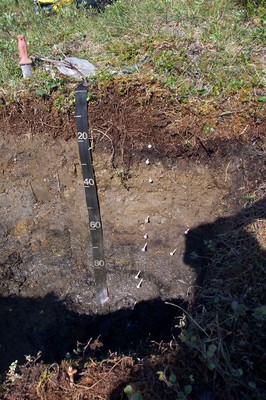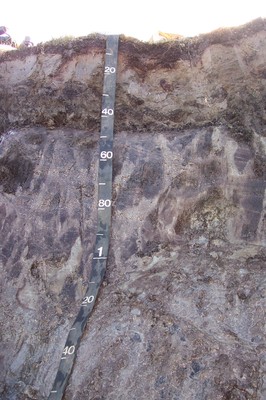
by Ari Hartmann Thursday, January 5, 2012

Researchers sampled soil in the Arctic and found that more carbon is locked up in the frozen soils than previously thought. Chien-Lu Ping

Chien-Lu Ping
Don’t look now, but a slumbering beast rests in the north. It’s not news that the North American Arctic, where trees dare not grow, contains immense amounts of organic carbon in its soils. But according to a new study, past estimates of organic carbon concentrations in Arctic soils are too low — and that has some scientists worried about vast amounts of carbon being released as temperatures warm.
Carbon enters soil when plants and animals die, and leaves soil when bacteria decompose these dead plants and animals, respiring carbon dioxide in the process. Most soils in the world are well drained and aerated, allowing bacterial decomposition to carry on efficiently. In the Arctic, however, poor drainage and freezing temperatures conspire to constrain decomposition.
Prior estimates of the Arctic soil carbon store are questionable, because scientists have used only a few, shallow soil samples to extrapolate what’s happening in the entire Arctic, say Chien-Lu Ping of the University of Alaska at Fairbanks and colleagues. To improve accuracy and precision, Ping and his team sampled more than a hundred locations to a depth of one meter in a variety of Arctic landscapes. Depth proved particularly important in the new estimate, Ping says, as nearly half of soil organic carbon resided 60 centimeters or deeper, due to the action of the freeze-thaw interface at that depth. The results were startling, the authors wrote in Nature Geoscience, Aug. 24. “Our paper revealed that there is more than double the Arctic soil carbon as previously estimated,” Ping says.
Refining the exact amount of Arctic soil carbon is not a purely academic exercise, Ping says. Scientists estimate that roughly 1,500 gigatons of available organic carbon are stored in soils worldwide, which is twice the current pool of atmospheric carbon dioxide. And 40 percent of this terrestrial organic carbon is locked away in the Arctic’s soil, Ping says, so it may play an important role in future climate change. The rate at which organic carbon is decomposed is temperature-dependant: the higher the temperature, the higher the rate. So even minor changes in temperature have the potential to release immense amounts of carbon dioxide into the atmosphere through accelerated soil decomposition.
Arctic soils are particularly sensitive. “Arctic soil organic matter is relatively fresh and undecomposed,” owing principally to frigid temperatures, Ping says. When temperatures rise sufficiently, decomposition may accelerate, he says, injecting carbon dioxide into the atmosphere.
© 2008-2021. All rights reserved. Any copying, redistribution or retransmission of any of the contents of this service without the expressed written permission of the American Geosciences Institute is expressly prohibited. Click here for all copyright requests.